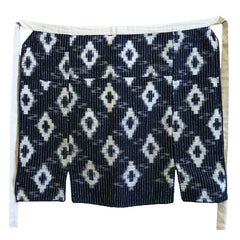A Heavily Sashiko Stitched Maekake: Traditional Apron
ca. mid twentieth century
19 1/4" x 21", 49 cm x 53.25 cm
Aprons were worn all the time in old Japan by all classes of people, especially working people.
Women at home wore them to do housekeeping, farmers and tradesmen wore them, shopkeepers wore them--in the past, aprons or maekake were part of one's daily clothing, and, still, today, many people today in Japan wear aprons on a daily basis.
This apron is most likely stitched in the mid twentieth century--and stitched it is.
The apron section of this garment is made of two layers of cotton cloth: the front is a large-scale kasuri or ikat which is indigo dyed; the back is a beautifully asagi iro or pale blue toned cotton.
These two layers are held together by tight, close, and tightly stitched rows of sashiko stitching, the vertical rows being about 1/4" or 1 cm apart from one another, the result looking like there is a steady rain of white stitches against the background of large, stepped diamond-shaped kasuri.
The tie is a length of heavy, powerloomed cotton that has been hand stitched to the sashiko-stitched kasuri base. This white cotton tie seems to be powerl oomed cotton.
All in all, this is a really attractive and beautifully presented sashiko stitched garment--and very tradition in its conception and execution.
Recommended.


